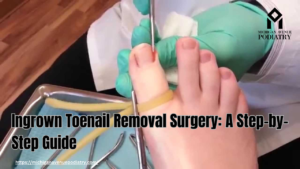Ingrown toenails can be incredibly painful and disruptive to daily life. Whether caused by improper nail trimming, tight-fitting shoes, or underlying health conditions, finding effective remedies is crucial for alleviating discomfort and preventing complications. In this article, we’ll explore 10 ingrown toenail remedies, including natural solutions, medication options, and professional interventions recommended by podiatrists and foot doctors.
10 Ingrown Toenail Remedies
- Warm Water Soaks:
Soaking your feet in warm water can help reduce swelling and tenderness associated with ingrown toenails. Add Epsom salts or mild antiseptic solutions to the water for added relief and to prevent infection. Aim for 15-20 minutes of soaking, two to three times daily, until symptoms improve.
- Proper Nail Trimming:
Proper nail trimming is essential for preventing and managing ingrown toenails. Trim nails straight across and avoid cutting them too short or rounding the corners, which can increase the risk of ingrowth. Use sharp, clean nail clippers and gently file any rough edges to prevent snagging.
- Cotton Ball Wedging:
Gently lifting the ingrown edge of the toenail with a small piece of cotton ball can help encourage proper nail growth and relieve pressure. After soaking your feet, carefully insert a small piece of cotton under the affected nail edge using clean tweezers. Replace the cotton daily to keep the area clean and dry.
- Over-the-Counter Pain Relievers:
Over-the-counter pain relievers such as ibuprofen or acetaminophen can help alleviate discomfort and reduce inflammation associated with ingrown toenails. Follow the dosage instructions on the packaging and consult with a healthcare professional if you have any underlying medical conditions or concerns.
- Antibiotic Ointments:
If there are signs of infection, such as redness, warmth, or pus drainage, applying an over-the-counter antibiotic ointment can help prevent further complications. Clean the affected area thoroughly before applying the ointment, and cover it with a sterile bandage to keep it clean and protected.
- Toe Spacers:
Toe spacers can help relieve pressure on ingrown toenails by separating the toes and preventing them from rubbing against each other. Silicone or foam toe spacers are available at most drugstores and can be worn inside shoes to provide cushioning and support.
- Foot Soaks with Tea Tree Oil:
Tea tree oil has natural antimicrobial and anti-inflammatory properties, making it a popular choice for treating ingrown toenails. Add a few drops of tea tree oil to warm water and soak your feet for 15-20 minutes to help reduce pain and swelling. Avoid using tea tree oil directly on open wounds or broken skin.
- Professional Nail Trimming:
If you’re unable to trim your ingrown toenail safely or if it becomes recurrent, consider seeking assistance from a podiatrist or foot doctor. They can trim the nail properly, remove any embedded fragments, and provide guidance on preventing future ingrown toenails.
- Partial Nail Removal (Nail Avulsion):
In severe cases where conservative treatments are ineffective, partial nail removal may be necessary to relieve chronic ingrown toenail pain. This procedure is typically performed under local anesthesia by a podiatrist and involves removing a portion of the nail or the entire nail to allow proper regrowth.
- Antibiotic Therapy:
For infected ingrown toenails that don’t respond to home remedies or minor interventions, oral antibiotic therapy may be prescribed by a healthcare professional. Antibiotics can help eliminate bacterial infections and promote healing, especially when combined with other treatment modalities.
Conclusion:
Ingrown toenails can be a source of significant discomfort and inconvenience, but with the right remedies and interventions, relief is within reach. Whether you opt for natural remedies, over-the-counter medications, or professional treatments, it’s essential to address ingrown toenails promptly to prevent complications and promote optimal foot health. Consult with a podiatrist or foot doctor for personalized recommendations and guidance tailored to your specific needs. By taking proactive steps and incorporating these ten ingrown toenail remedies into your routine, you can find relief and get back on your feet with confidence.


